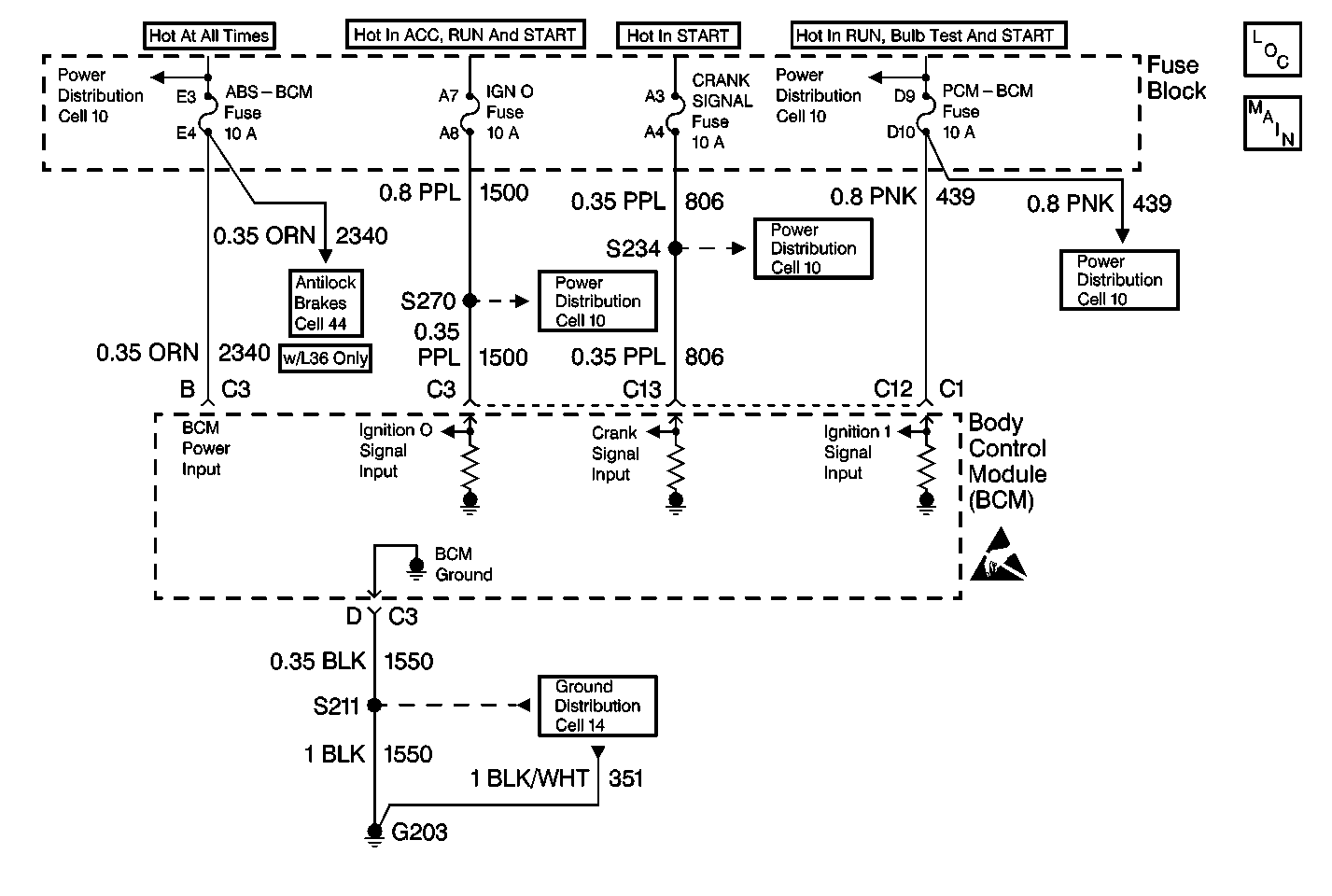
Circuit Description
The BCM receives three voltage inputs. The BCM receives voltage from the IGN 0 fuse through circuit 1500 at all times except when the ignition switch is off. The BCM receives voltage from the PCM-BCM fuse through circuit 439 when the ignition switch is in the on or start position. The BCM receives voltage from the CRANK SIGNAL fuse through circuit 806 when the ignition switch is in the start position.
Conditions for Setting the DTC
The BCM sets DTC B0608 when detecting any of these conditions for more than 0.3 seconds:
| • | Voltage in circuit 439 is high and voltage in circuit 1500 is low. |
| • | Voltage in circuit 806 is high and voltage in circuit 1500 is low. |
| • | Voltage in circuit 806 is high and voltage in circuit 439 is low. |
Action Taken When the DTC Sets
the BCM stores DTC B0608 in memory.
Conditions for Clearing the DTC
| • | The BCM no longer detects an open or short to B+ in circuits 439, 806, or 1500. |
| • | A history DTC will clear after 100 consecutive ignition cycles if the condition for the malfunction is no longer present. |
| • | Using a scan tool. |
Diagnostic Aids
The following conditions may cause an intermittent malfunction to occur:
| • | An intermittent open or short to B+ in circuit 439, 806, or 1500. |
| • | Poor connections at the BCM, or the fuse block. |
| • | The BCM is always detecting B+ in circuits 439, 806, or 1500. |
| • | The BCM is never detecting B+ in circuits 439, 806, and 1500. |
DTC P1626 will set in the Powertrain Control Module (PCM) when the ignition switch is on with the Body Control Module (BCM) disconnected. when BCM diagnostics and repairs are completed, refer to Powertrain Control Module Diagnosis in Engine Controls for additional information on PCM related DTCs.
Test Description
The numbers below refer to the step numbers on the diagnostic table.
-
This step checks for a short to ground in circuit 806.
-
This step checks for a short to ground in circuit 1500.
-
This step checks for a short to B+ in circuit 1500.
-
This step checks for an open in circuit 439.
-
This step checks for a short to B+ in circuit 806.
-
This step checks for an open in circuit 806.
-
This step checks for a short to B+ in circuit 1500.
-
This test checks for an open in circuit 1500.
-
This test determines whether the malfunction is intermittent or the BCM is faulty.
Step | Action | Value(s) | Yes | No | ||||||
|---|---|---|---|---|---|---|---|---|---|---|
1 | Was the BCM Diagnostic System Check performed? | -- | ||||||||
Check the CRANK SIGNAL fuse. Is the CRANK SIGNAL fuse open? | -- | |||||||||
3 |
IMPORTANT: The engine may start. Is the CRANK SIGNAL fuse open again? | -- | ||||||||
Check the IGN 0 fuse. Is the IGN 0 fuse open? | -- | |||||||||
5 |
Is the IGN 0 fuse open again? | -- | ||||||||
Does the test light stay off? | -- | |||||||||
7 |
IMPORTANT: The engine may start. Was the test light on with the ignition switch in the on and start position? | -- | ||||||||
Did the test lamp stay off when turning the ignition switch from off to on? | -- | |||||||||
IMPORTANT: The engine may start. Did the test lamp turn on when turning the ignition switch to START? | -- | |||||||||
Does the test lamp stay off? | -- | |||||||||
IMPORTANT: The engine may start. Did the test light turn on with the ignition switch in the ACC, on or START position? | -- | |||||||||
Does DTC B0608 reset as a current DTC? | -- | |||||||||
13 | Repair short to ground in circuit 806. Is the repair complete? | -- | -- | |||||||
14 | Repair short to ground in circuit 1500. Is the repair complete? | -- | -- | |||||||
15 | Repair short to voltage in circuit 439. Is the repair complete? | -- | -- | |||||||
16 | Repair poor connection or open in circuit 439. Is the repair complete? | -- | -- | |||||||
17 | Repair short to voltage in circuit 806 or a faulty ignition switch. Is the repair complete? | -- | -- | |||||||
18 | Repair poor connection or open in circuit 806. Is the repair complete? | -- | -- | |||||||
19 | Repair short to voltage in circuit 1500 or a faulty ignition switch. Is the repair complete? | -- | -- | |||||||
20 | Repair poor connection or open in circuit 1500. Is the repair complete? | -- | -- | |||||||
21 |
Is the repair complete? | -- | -- | |||||||
22 | The malfunction is not present at this time. Refer to Diagnostic Aids for additional information regarding this DTC. Is the action complete? | -- | -- | |||||||
23 |
Are there any BCM current DTCs set? | -- | System OK |
